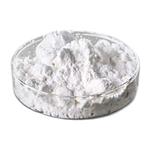Usage And Synthesis
Amylin is a pancreatic β-cell hormone co-secreted with insulin in response to nutrient intake. Amylin, released with insulin from beta cells in the pancreas, induces its satiating effect via both the homoeostatic and hedonic regions of the brain. Cagrilintide is the first long-acting amylin analogue being investigated for weight management as a once-weekly treatment in combination with semaglutide. Semaglutide, a GLP-1 receptor agonist, reduces appetite via GLP-1 receptors in the hypothalamus, increases insulin production, and reduces glucagon secretion, delaying gastric emptying. These separate but related mechanisms of action of an amylin-analogue and a GLP-1 receptor agonist appear to have an additive effect on appetite reduction[1].
Cagrilintide is an amylin-analog, now being developed in combination with the GLP-1 agonist semaglutide to achieve sustained weight loss in persons with overweight and obesity. This drug is an investigational therapy that reduced body weight in a phase 2 trial when administered as monotherapy in participants without diabetes and with a BMI of at least 30 kg/m2 or at least 27 kg/m2 with hypertension or dyslipidaemia[1-2].
Cagrilintide, a non-selective agonist, is designed for weekly subcutaneous injection at low pH. It is based on the h-amylin backbone, drawing inspiration from calcitonin, and exhibits a prolonged action profile, likely attributed to reversible albumin binding similar to semaglutide. This amylin analog is currently under development in combination with the GLP-1 agonist semaglutide to achieve sustained weight loss in individuals with overweight and obesity. Amylin, co-secreted with insulin from pancreatic beta cells, exerts its satiating effect through both the homoeostatic and hedonic brain regions. On the other hand, semaglutide, a GLP-1 receptor agonist, reduces appetite by acting on GLP-1 receptors in the hypothalamus, increases insulin production, and decreases glucagon secretion, thus delaying gastric emptying. These distinct yet interconnected mechanisms of action of an amylin analog and a GLP-1 receptor agonist appear to synergistically reduce appetite[3].
The most frequent adverse events were gastrointestinal disorders (e.g., nausea, constipation, and diarrhoea) and administration-site reactions. More participants receiving cagrilintide 0·3-4·5 mg had gastrointestinal adverse events compared with placebo (41%-63% vs 32%), primarily nausea (20%-47% vs 18%)[4].
In a phase 2 dose-finding trial in people with overweight or obesity and hypertension or dyslipidaemia and without type 2 diabetes, cagrilintide 2·4 mg, as an adjunct to diet and exercise, resulted in a bodyweight reduction of 10% versus 3% with placebo after 26 weeks. Furthermore, a phase 1b trial investigating doses of cagrilintide up to 4·5 mg co-administered with semaglutide 2·4 mg in people with overweight or obesity reported a mean bodyweight reduction of 17% with cagrilintide 2·4 mg and semaglutide 2·4 mg versus 10% with co-administered semaglutide 2·4 mg and placebo after 20 weeks. Thus, combining these agents with different but complementary mechanisms of action can potentially increase efficacy. It was, therefore, deemed relevant to investigate whether once-weekly subcutaneous co-administration of semaglutide and cagrilintide (both escalated to 2·4 mg) improves glycaemic and weight control when compared with cagrilintide or semaglutide alone in people with type 2 diabetes and overweight or obesity.
[1] Antonella M D’Ascanio, William H Frishman, & Jamie A Mullally. “Cagrilintide: A Long-Acting Amylin Analog for the Treatment of Obesity.” Cardiology in Review (2024): 83–90.
[2] Juan P Frias. “Efficacy and safety of co-administered once-weekly cagrilintide 2·4 mg with once-weekly semaglutide 2·4 mg in type 2 diabetes: a multicentre, randomised, double-blind, active-controlled, phase 2 trial.” Lancet 402 10403 (2023): 720–730.
[3] Thomas Kruse*. “Development of Cagrilintide, a Long-Acting Amylin Analogue.” Journal of Medicinal Chemistry 64 15 (2021): 11183–11194.
[4] David C W Lau. “Once-weekly cagrilintide for weight management in people with overweight and obesity: a multicentre, randomised, double-blind, placebo-controlled and active-controlled, dose-finding phase 2 trial.” Lancet (2021): 2160–2172.
[2] Juan P Frias. “Efficacy and safety of co-administered once-weekly cagrilintide 2·4 mg with once-weekly semaglutide 2·4 mg in type 2 diabetes: a multicentre, randomised, double-blind, active-controlled, phase 2 trial.” Lancet 402 10403 (2023): 720–730.
[3] Thomas Kruse*. “Development of Cagrilintide, a Long-Acting Amylin Analogue.” Journal of Medicinal Chemistry 64 15 (2021): 11183–11194.
[4] David C W Lau. “Once-weekly cagrilintide for weight management in people with overweight and obesity: a multicentre, randomised, double-blind, placebo-controlled and active-controlled, dose-finding phase 2 trial.” Lancet (2021): 2160–2172.
PROMPT×
PROMPT
The What'sApp is temporarily not supported in mainland China
The What'sApp is temporarily not supported in mainland China
Cancel
Determine


